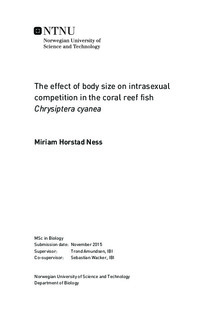The effect of body size on intrasexual competition in the coral reef fish Chrysiptera cyanea
Master thesis
Permanent lenke
http://hdl.handle.net/11250/2367335Utgivelsesdato
2015Metadata
Vis full innførselSamlinger
- Institutt for biologi [2514]
Sammendrag
Intrasexual competition is considered important in driving selection on morphological traits, and the role of body size in male-male competition is well studied in a wide range of animals. In coral reef fishes however, there are still aspects left relatively unexplored, such as the competitive dynamics between different sized males. The effects of body size on intrasexual competition in the damselfish Chrysiptera cyanea were studied, investigating both the nature and outcome of the competitions. Dyads of male Chrysiptera cyanea were allowed to interact using a standardized experimental set up, and agonistic behaviours, resource monopolization and area use were recorded. Larger males performed considerably more chases than smaller males, were more successful in monopolizing the available resources and spent more time in the lower area of the aquarium, closer to the potential resources. Theory for conflict resolution predicts intrasexual conflicts to start with low-risk behaviours and follow a certain behavioural pattern. In addition, a more escalated conflict and a less predictable outcome are expected when size asymmetries are small. As predicted, both males showed a high frequency of visual fin displays, and more escalated behaviour was done increasingly towards the end and almost exclusively by the larger male. Despite an overall small difference in within pair body size (larger male < 10% longer than smaller male in total length), conflict outcome was clear with the larger male showing competitive superiority. These results thus emphasize the importance of size advantage in intrasexual competition between male C. cyanea, and suggest that male-male competition is likely to be involved in creating selection on body size in the wild.
